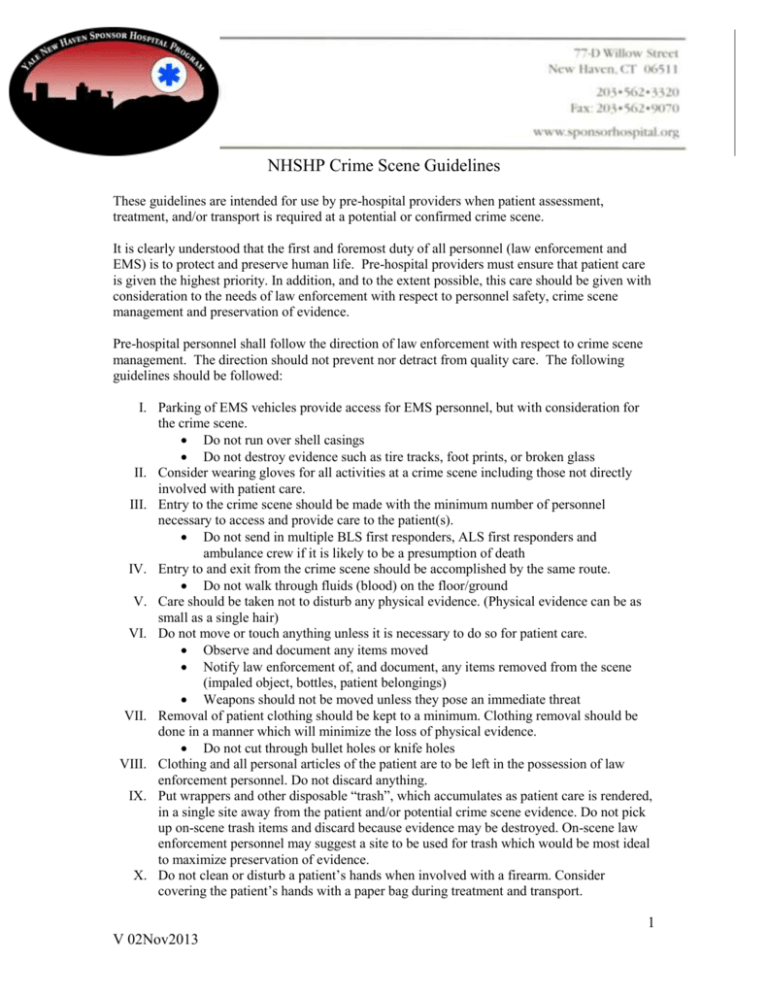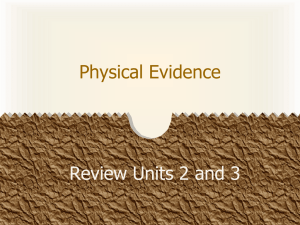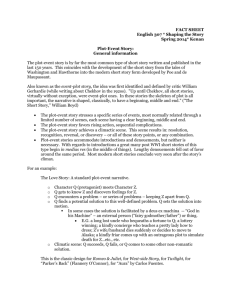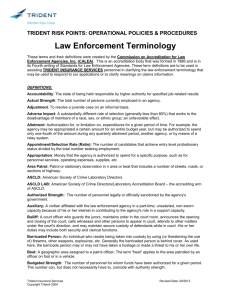YNHSHP Crime Scene Guidelines - New Haven Sponsor Hospital
advertisement

NHSHP Crime Scene Guidelines These guidelines are intended for use by pre-hospital providers when patient assessment, treatment, and/or transport is required at a potential or confirmed crime scene. It is clearly understood that the first and foremost duty of all personnel (law enforcement and EMS) is to protect and preserve human life. Pre-hospital providers must ensure that patient care is given the highest priority. In addition, and to the extent possible, this care should be given with consideration to the needs of law enforcement with respect to personnel safety, crime scene management and preservation of evidence. Pre-hospital personnel shall follow the direction of law enforcement with respect to crime scene management. The direction should not prevent nor detract from quality care. The following guidelines should be followed: I. Parking of EMS vehicles provide access for EMS personnel, but with consideration for the crime scene. Do not run over shell casings Do not destroy evidence such as tire tracks, foot prints, or broken glass II. Consider wearing gloves for all activities at a crime scene including those not directly involved with patient care. III. Entry to the crime scene should be made with the minimum number of personnel necessary to access and provide care to the patient(s). Do not send in multiple BLS first responders, ALS first responders and ambulance crew if it is likely to be a presumption of death IV. Entry to and exit from the crime scene should be accomplished by the same route. Do not walk through fluids (blood) on the floor/ground V. Care should be taken not to disturb any physical evidence. (Physical evidence can be as small as a single hair) VI. Do not move or touch anything unless it is necessary to do so for patient care. Observe and document any items moved Notify law enforcement of, and document, any items removed from the scene (impaled object, bottles, patient belongings) Weapons should not be moved unless they pose an immediate threat VII. Removal of patient clothing should be kept to a minimum. Clothing removal should be done in a manner which will minimize the loss of physical evidence. Do not cut through bullet holes or knife holes VIII. Clothing and all personal articles of the patient are to be left in the possession of law enforcement personnel. Do not discard anything. IX. Put wrappers and other disposable “trash”, which accumulates as patient care is rendered, in a single site away from the patient and/or potential crime scene evidence. Do not pick up on-scene trash items and discard because evidence may be destroyed. On-scene law enforcement personnel may suggest a site to be used for trash which would be most ideal to maximize preservation of evidence. X. Do not clean or disturb a patient’s hands when involved with a firearm. Consider covering the patient’s hands with a paper bag during treatment and transport. 1 V 02Nov2013 XI. Patients who meet the “obvious death” criteria do not require EKG confirmation of asystole, or any manipulation of the body. These include: Decapitation Incineration of 90% or more of the total body surface area Decomposition or putrefaction Transection of the torso Dependent lividity with rigor Patients total incineration of torso and/or head Decomposition Total separation of vital organs from body or total destruction of these organs accompanied by no detectable pulse or respirations. Note: A single person can rapidly assess for pulse and respirations. Any other injury not compatible with life in a pulseless apneic patient XII. Patient who meet the criteria for withholding resuscitative efforts should be assessed using the minimum number of EMS personnel. EKG confirmation of asystole should be completed with minimal movement of the body. XIII. It is important to realize that law enforcement personnel have the authority to presume death. If death has been presumed by a law enforcement officer, medical confirmation procedures do not need to be performed by pre-hospital providers unless requested. It is, however, important to document the name and badge number of the officer presuming death or limiting access to the scene for patient assessment as the liability for such a decision will rest with him/her, and his/her department. XIV. Every effort to cooperate with law enforcement should be made. In the event of a disagreement with law enforcement, EMS personnel should document the problem and refer the matter to their superior for follow-up and/or action. If the disagreement involves, in the opinion of the pre-hospital provider, an issue that will or could result in patient harm, an immediate request for on-scene supervisory personnel should be made, including consideration for direct medical oversight advice. XV. In the event that EMS personnel discover a crime scene, or are at a crime scene without law enforcement, an immediate request for law enforcement shall be made. Until such time as law enforcement arrives, EMS personnel shall assure their own safety and if possible, attempt to follow the guidelines contained in this document. XVI. Laundering of the scene at the completion of the investigation is not routinely in the scope of responsibility for the EMS or fire agencies and therefore these requests should be referred to the appropriate resources for completion of scene management. 2 V 02Nov2013









